Strength Training for Runners: Is it such a simple approach
By Mike James | 27th November 2018 | Advice
Sports Injury Fix Director, and endurance specialist Physio Mike James (The Endurance Physio) has spent 20 years working with runners and endurance athletes. Here he discusses the evidence for the hotly debated topic of strength training and asks whether its as simple as just doing it!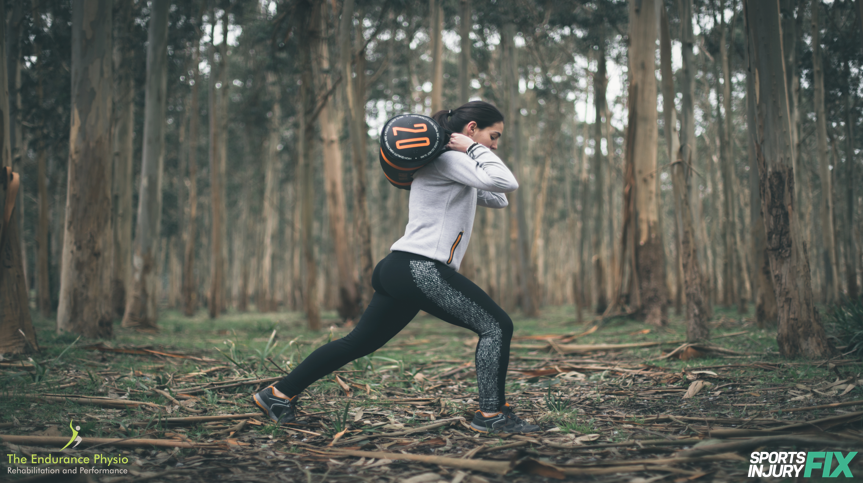
The injury incidence among endurance athletes varies between 11–85% (Buist et al, 2010), or 2.5 to 38 injuries per 1000 hours of running (van Gent et al, 2007).
A deep dive through the research tends to leave us with the message of "athletes get injured when we exceed the capacity or tolerance of the musculoskeletal system".
Intuitively, we therefore tend to adopt the belief that if we increase the capacity of the system to reduce risk and improve performance, or increase robustness when rehabilitating from injury then it seems sensible to prescribe strength work right?
I certainly used to buy into this (my bias is to always add strength work, but i must confess, for many years I cherry picked the available evidence to support my bias).
If we consider that assumption more closely, we see that to really understand it then there is two distinctly separate questions we need to answer....
"if we increase the capacity of the system to reduce risk and Improve performance, or increase robustness when rehabilitating from injury then it seems sensible to prescribe strength work……..
So lets split it up and look at the two areas:
Performance
In short, its a YES to this.
We have over 30 years of supporting research on positive effects of strength training on endurance performance and economy. We know that greater gains are made doing strength and endurance training in combination compared to endurance training alone (Hickson et al,1988), (Hoff et al, 2002), (Losnegard et al, 2011), (Ronnestad et al. 2010 and 2012). Resistance and or explosive strength training has been shown to lead to significant improvements in running economy (Cheng et al., 2012; Mikkola et al., 2011; Taipale et al., 2010 and many more), and amongst the other benefits we find strength training can lead to neuromuscular improvements (Mikola et al., 2007), increased muscle cross sectional area without increases in body weight (Rønnestad et al., 2010a) ,and appears to increase the proportion of energy from aerobic energy systems (Minahan and Wood 2008).
But the kicker for anyone trying to sell the benefits for performance is simply this:
It works for everyone!
Injury prevention
This is where the waters start to get muddy.
As a therapist, I (and many others) have searched for the golden egg to support our biases that we should be strength training to reduce injury risk.
But the evidence is simply lacking for to support this. Then a few years ago a massive study emerged with some big, bold claims stating that....
 Sexy numbers that had us salivating and waxing lyrical over the power and size of the study.
Sexy numbers that had us salivating and waxing lyrical over the power and size of the study.
This is what we had been waiting for!
BUT......
and its a big but......
Out of the 25 studies included zero were specific to running! The trials included athletes, footballers, army recruits and general members of the public, but no studies were focused on reducing injury risk specifically in endurance athletes
Its encouraging that benefits were shown across sporting populations, but we cannot extrapolate more than the study actually finds, yet we still see this on therapists websites and social media constantly.
So why are therapists doing this?
It's probably a multitude of reasons, and some are to challenge outdated beliefs and myths that are sometimes perpetuated in running circles that strength training is detrimental to runners.
So in short, runners should be strongly considering adding strength work to their training to help improve their performance, but at the current time, we cannot say it will reduce injury risk substantially.
I do feel it plays a pivotal part in rehabilitating running injury coupled with appropriately gauged return to running protocols.
How should we do it?
First and foremost, we need to keep it simple. Don't over complicate it with overly complex exercises, jargon and over coaching.
Try to find the exercises that give YOU the most bang for your buck in the time you have available.
There is no magic exercise, it needs to work for the time, space, equipment that you have available.
Less is more - progress an exercise until its exhausted before adding more or changing exercises for the sake of it!
Here's some tips on getting started from scratch.....
The key is to keep it simple and then progress as you feel comfortable and see benefit. We know that a large proportion of people fail to adhere to exercise, even when part of a rehabilitation plan, and a major factor in this is unclear instructions. For that reason I believe that the top two tips when starting are:
1. Do it at home
2. Use Body weight exercises
The guide below gives a simple regime of 6 exercises that can be completed 2-3 times a week and less than 20 minutes a session.
As with all training regimes, compliance is key, and I have designed a simple regime of home, body weight based exercises for the runner to try.
Blagrove et al (2018) states that the most effective type of training prescription is difficult to identify at present but suggests an optimal dosage may be 2-3 x week for 6-14 weeks (longer is better!) and when run training increases in the lead up to a race, then once weekly may be sufficient to maintain gains.
On a practical level, try to allow 3 hrs after high intensity running before performing strength training, and allow at least 24 hrs recovery afterwards before completing high intensity running.
Aim to complete 4 sets of 8-12 repetitions of each exercise. This can be performed as a circuit or one exercise at a time. Allow around 30-60 seconds rest between sets as required.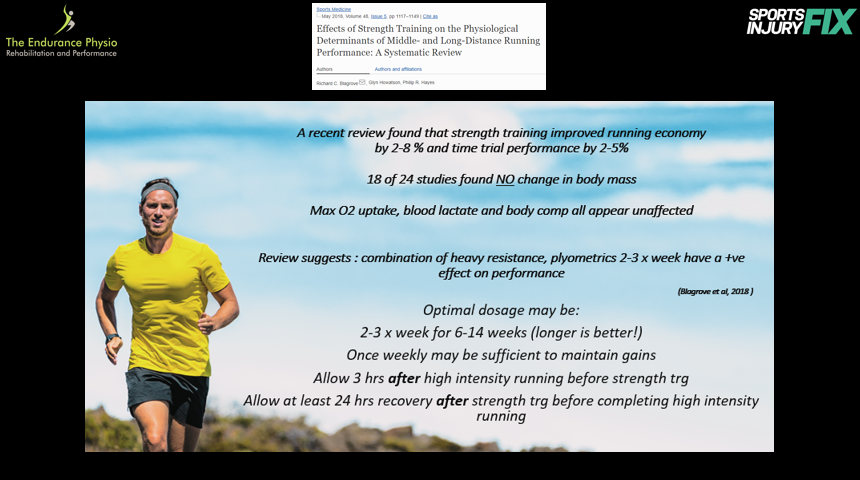
Should the exercises become easy, or you are already performing body weight exercises, then adding some resistance as shown below is advised. Simple equipment such as water bottles, sand bags, rucksacks filled with books will add extra resistance, however, if you have access to simple fitness equipment such as dumbbells, kettlebells and resistance band, then they work well also. Again, aiming for 8-12 repetitions per set, 3-4 times.
This is by no means an exhaustive list of exercises for the runner. They are simply an introduction to strength training at home. Exercise dosages are simply a starting point for the general runner and should the runner wish for further progression and/or to develop specific components of strength, such as power or plyometric ability, then guidance should be sought from an expert.
Exercise 1 - Squat
Squatting is a common daily task that is common place in many strength training regimes. When we look for “most bang for your buck” type exercises, then it’s no surprise the squat is at the top of the list. By nature of its multi joint strength and control demands encompassing many types of muscle contraction, then it becomes a fundamental exercise for the runner.
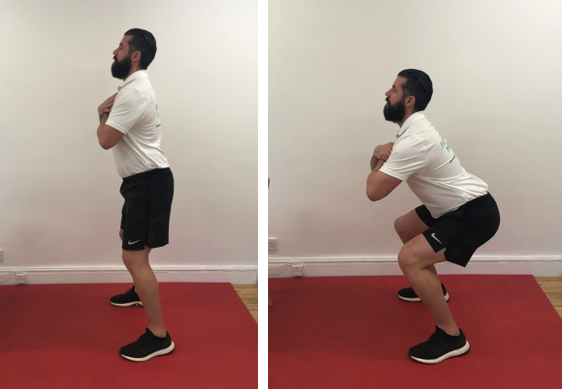
Air squat – feet shoulder width apart, stay tall and strong, lower with control to a depth you can control and then drive through the legs to return to the start position.
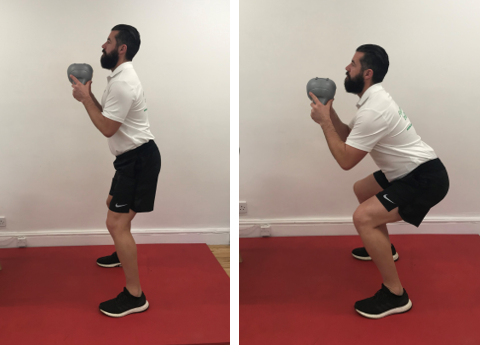
Progression – add resistance – this variation is called the goblet squat and adds both resistance to the lower limb and trunk control. Wearing a ruck sack converts the exercise to a traditional back squat type movement. Try to avoid excessive forward lean, knees tracking over the toes and the knees collapsing inwards at the bottom of the squat. Try to keep the chest up as if to show off your favourite race T-shirt to someone in front of you. Progression through to heavier resistance and / or a single leg squat variation would be appropriate.
Exercise 2 - Deadlift
Another fantastic multi joint movement with excellent emphasis on the posterior chain. Whereas the squat is a knee driven exercise, the deadlift is a hip driven movement, meaning, most movement is a pivot / hinge at the hip whilst keeping an upright strong trunk. The knees will need to bend when you feel the hamstrings pull. Only lower as far as you feel you can control, then drive back to start.
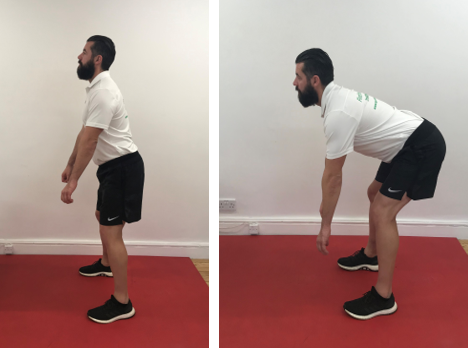
The deadlift can be a difficult exercise to master and may require practise of a simple hip hitch movement before developing into the full technique. A simple technique is to stand a few inches from the wall, try to touch your buttocks against the wall without bending the trunk or knees.
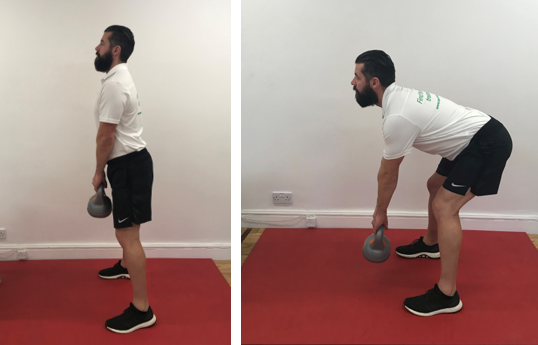
If performing well, add resistance as above, or try a single leg version (below). Running involves significant amounts of single leg support and control and this is an excellent exercise for targeting this. It is an advanced technique and takes time to master.
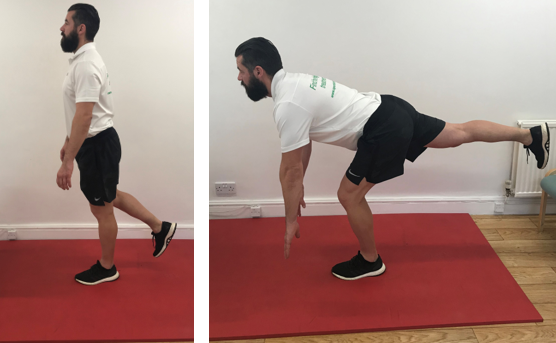
For each deadlift variation, aim to keep your hips higher than your knees, your buttocks moving back rather than down, and your trunk and upper limbs square and facing forward.Add resistance again as tolerated.
Exercise 3 - Calf Raise
An essential exercise for runners. The calf complex and Achilles tendon transmit and absorb massive forces and increased capacity in these tissues will almost definitely benefit the runner. Begin with a finger tip supported drill if required, potential strength gains and loading should not be affected by limitations in balance and coordination. Always concentrate on full range movement right up onto tip toes and with control. Time under tension is crucial for these muscles.
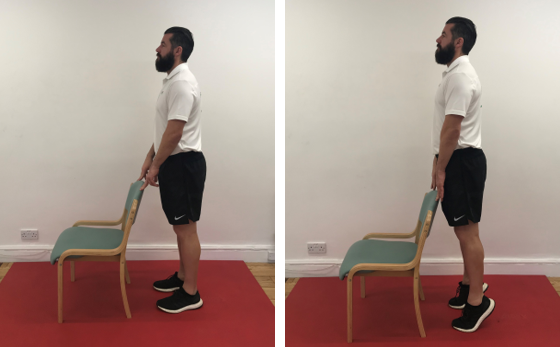
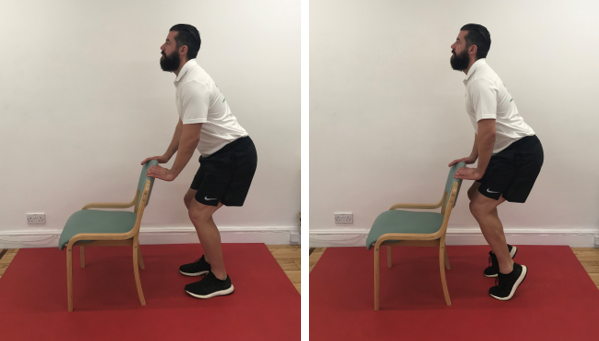
Perform with both straight leg (Gastrocnemius biased) and bent leg (Soleus biased) variations to maximise effect. The key cue is to always move in a vertical direction with the ball of your foot in contact with the floor.
Performing on single leg is an effective progression (straight leg shown only but remember to perform with bent leg also.
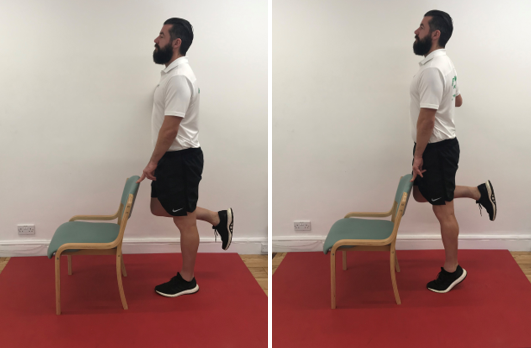
Finally, performing both types over a step / stair will allow you to take the heel “below the level of the floor” and increase the range the muscles can work through. An effective strategy for increasing resistance safely is to use a rucksack with weight in it. This will allow you to maintain your hands in a free position should fingertip support be required. These progressions are merely options and do not all necessarily need to be performed to progress. Simply adding load and / or more time under tension (taking longer to perform the repetition) may be appropriate.
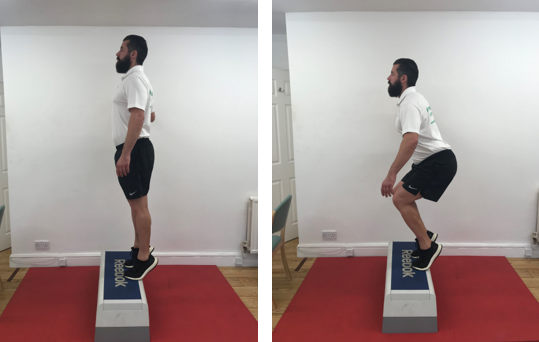
Exercise 4 - Bridge
Another fantastic posterior chain activity, easily performed at home without the need for expensive, complicated equipment. Begin with the double leg variation. Raise your buttocks/trunk off the floor, aiming to achieve an imaginary straight line running through your knees, hips and shoulders, variations include a very slow and controlled raise/lower or a faster raise and lower with a small pause at the top position.
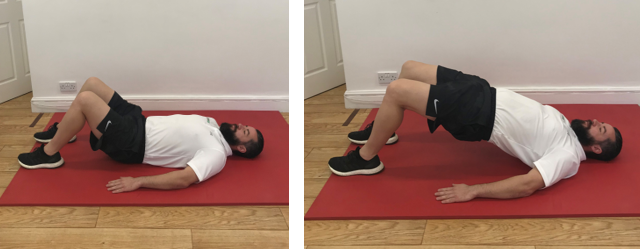
Key errors to avoid are overarching of the lower back, failure to raise to the top position and holding the breath throughout the movement. Play around with foot positions to bias certain muscle groups more or less than others. Bringing the heels closer will increase Gluteal work, whilst moving them further away will increase hamstring activity – be careful they don’t cramp!
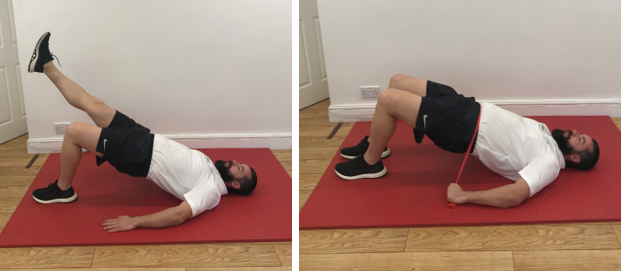
To progress either move onto a single leg variation or add resistance across the pelvis as illustrated below.
The resistance band can also be performed on the single leg variation as required.
Exercise 5 - Step Up
Another great fundamental exercise that demands stability and control throughout the single leg as per the actions required for every stride when running. Be cautious when selecting the height of the step to be used. Don’t get too ambitious too soon if new to this exercise. Key coaching cues include driving up through the weight bearing foot/leg and maintain control throughout. Many runners perform this exercise based on the momentum generated from the movement and this should be avoided. Remember the resistance level used shouldn’t compromise the control on the down phase whilst returning to the floor.
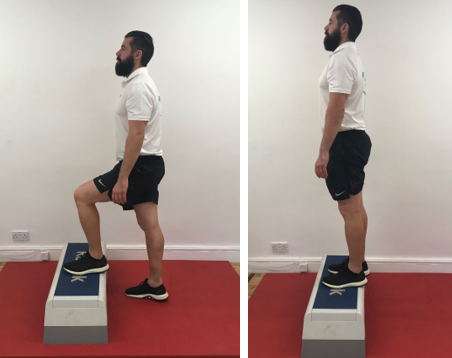
Adding an upper limb movement that replicates a running pattern whilst progressing to a high knee step up variation is an effective technique for runners to develop.Once mastered, adding resistance to the step up (again, a loaded rucksack is often sufficient) can be effective. Other techniques to increase resistance include the following. Give them a go and see which ones you find the most beneficial.
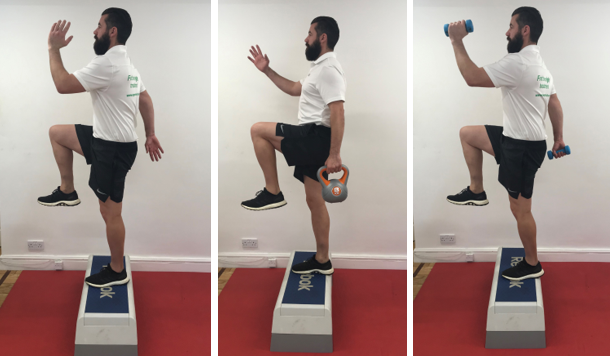
Exercise 6 - Core
The topic of core strengthening is much debated and controversial. Many exercises such as the plank have been advocated as effective exercises for runners. Personally, I feel core work needs to include two aspects: controlled rotation and an anti-rotation element to encompass the demands of running. Here are two variations that focus on these aspects.
6a. Anti-Rotation via Pallof press
I find resistance band is perfect for this drill. A resistance band can be found in many high street shops and/or online. It is manufactured in different grades of resistance differentiated by colour.
For this exercise – position yourself so that there is enough tension on the band to make you feel like your trunk wants to rotate towards the band. Whilst resisting the rotation, drive /push your arms forward, this will increase lever length and increase the effort needed to resist rotation towards the band. Perform with the band pulling from both sides of your body. It can be performed in kneeling or standing depending on level of ability. I particularly like the single leg standing variation as a high-level drill, but as with all the exercises, this requires time and patience to master and progress to.
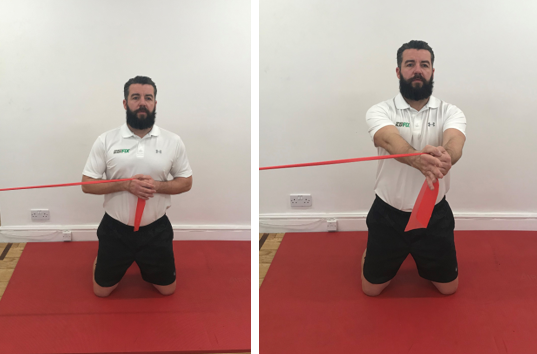
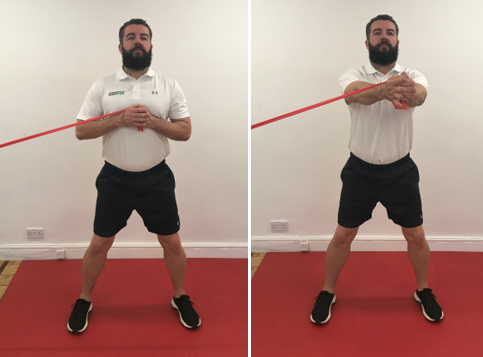
6b. Rotations
For this exercise the intention is to do the exact opposite of the Pallof press. We are aiming to rotate against the band whilst maintaining control throughout. Focus on trying to rotate through the trunk and not by simply turning the hips and pelvis. Again, perform in kneeling, standing or eventually on single leg, progressing only when control is effectively maintained. It is important to maintain control on the return to the start; a common mistake is to use a resistance that is too heavy, and the return phase becomes a recoil as opposed to a controlled movement.
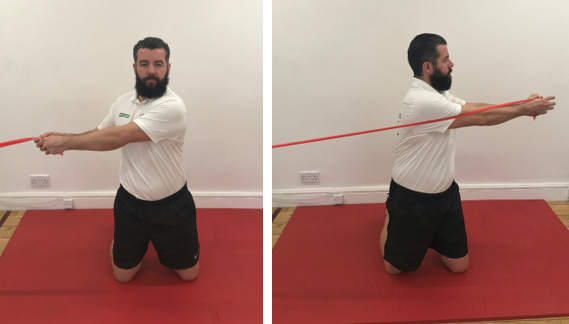
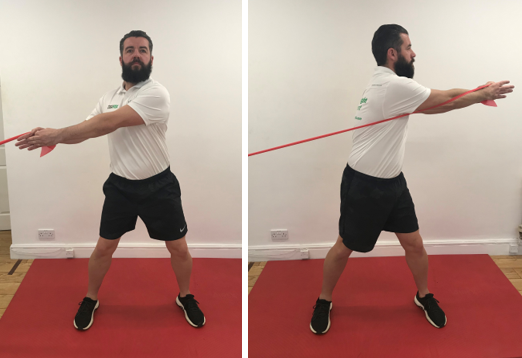
Hopefully you have found this helpful, for more run related blogs click here
If you would like to find a running specialist therapist in your area, please visit sportsinjuryfix.com
